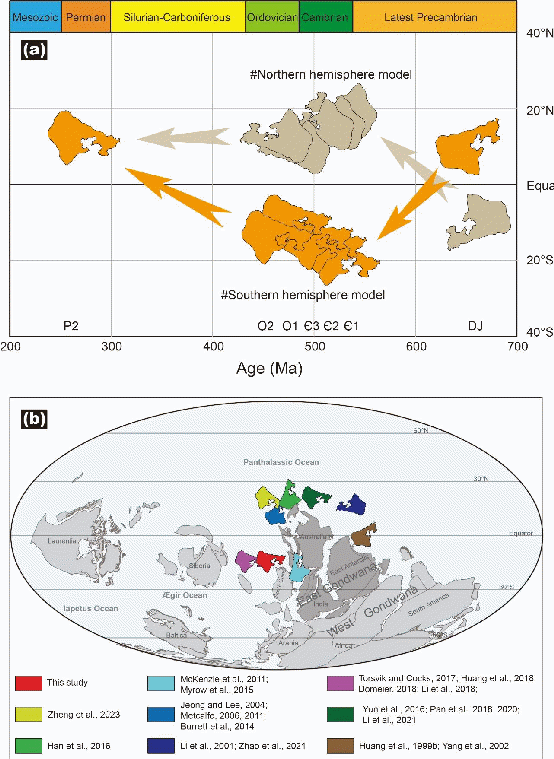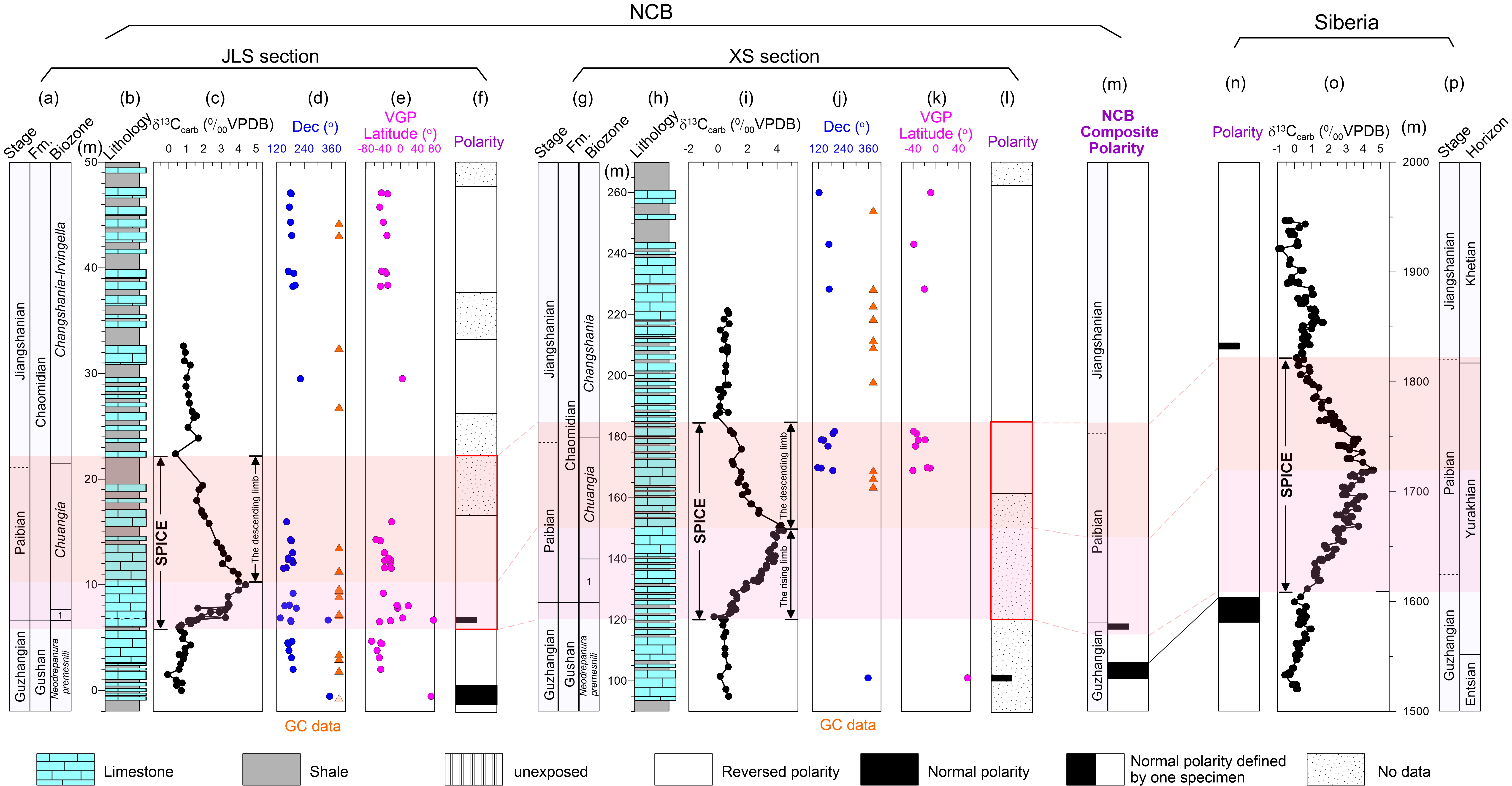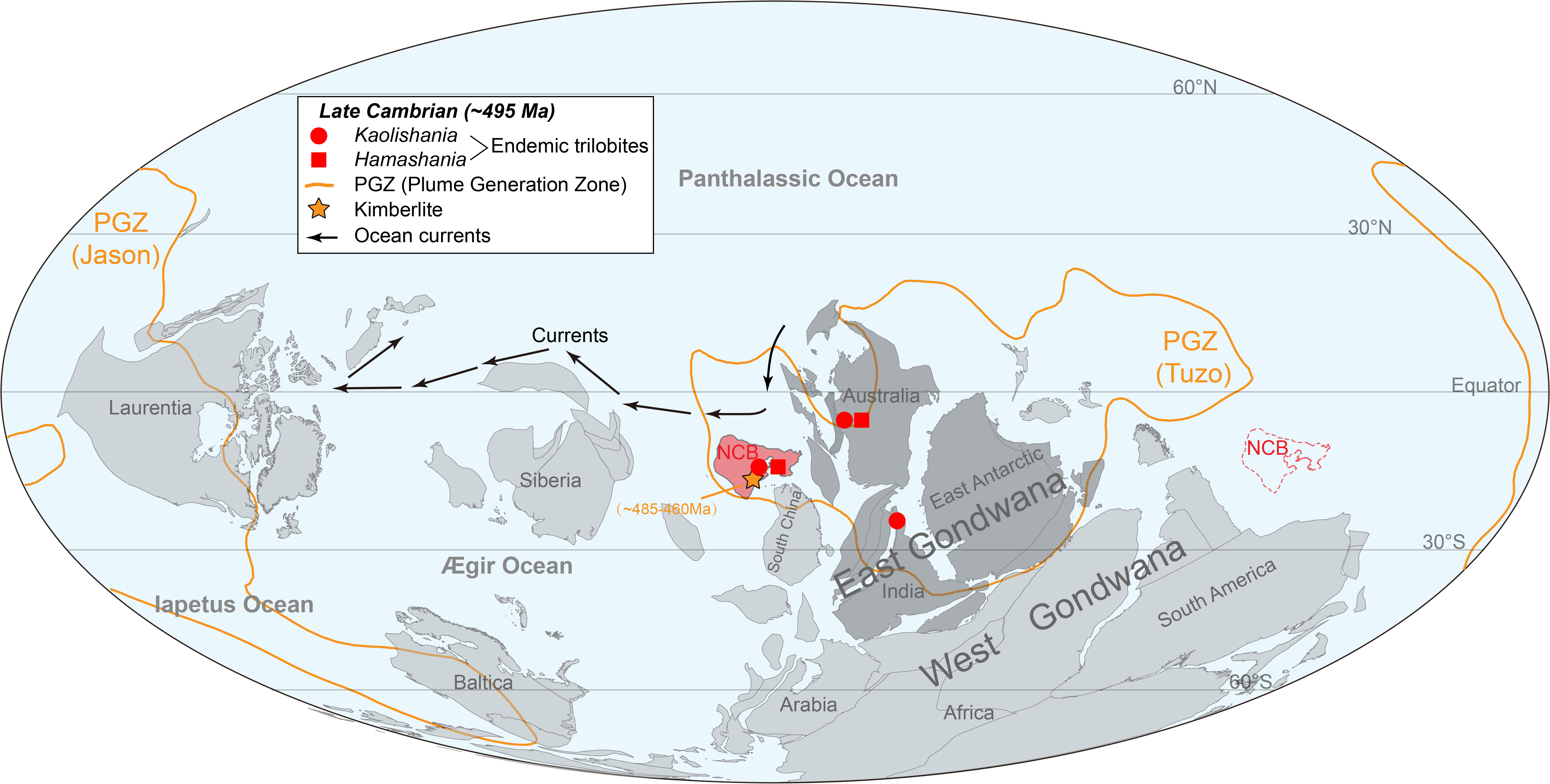North China Block (NCB) is one of three major plates that constitute the tectonic framework of China. Quantitative reconstruction of paleogeographic positions and displacement of the NCB in the geological history is the basis for unraveling into the kinematics, geodynamic processes and the accompanying environment and biological evolution. One common practice is to determine the paleo-position of a block by examining the fossil record of past geomagnetic field information documented in rocks formed in the block. This practice can face challenges when dealing with deep-time paleogeographic reconstructions due to the occurrence of geomagnetic polarity ambiguity. For instance, a downward pointing paleo-direction could be acquired in the northern hemisphere during a normal polarity interval or in the southern hemisphere during a reversed polarity interval. Such polarity ambiguity leads to ambiguous interpretations of paleo-geographic positions, that is, a block could be situated in either southern hemisphere or northern hemisphere. It has been the long-standing controversy for the NCB as to whether the NCB was located in the southern or northern hemisphere in early Paleozoic. This issue is particularly important as different locations of the NCB imply different trajectories of the NCB displacement histories from the latest Pre-Cambrian to the late Paleozoic (Figure 1), and thus different tectonic processes, geodynamic causal mechanisms, and possibly different environmental and biological evolutionary histories. Aiming to resolve this issue, the research group led by Prof. Yong-Xiang Li from the School of Earth Sciences and State Key Laboratory for Mineral Deposits Research in Nanjing University investigated the magnetostratigraphy across the Steptoean positive carbon isotope excursion (SPICE) interval from two upper Cambrian successions in the NCB and determined the polarity for the NCB during the late Cambrian by comparing the magnetostratigraphy of the two NCB sections with coeval and well established magnetostratigraphy of the stable Siberia (Figure 2).

Figure 1 The controversy about the paleo-position of the North China Block (NCB) in Cambrian: southern hemisphere or northern hemisphere, each corresponding to different displacement trajectories from the latest Pre-Cambrian to late Paleozoic.

Figure 2 The simplified tectonic map of the North China Block (NCB) showing the locations of the two studied sections: Jiulongshan section and Xishan section (asterisks in a) and the regional geology of the two sections (b, c). The legends are shown in (d).
The SPICE was a paleoceanographic and paleoclimate event in late Cambrian that perturbed the global carbon cycling and was marked by a distinct positive carbon isotope excursion. The SPICE was accompanied by the extinction of some trilobite species. On the basis of biostratigraphy and carbon isotope chemostratigraphy of the Jiulongshan section in Shandong Province and Xishan section in Liaoning Province that delineate the SPICE intervals in the two sections, the research group conducted a comprehensive magnetostratigraphic study of the two sections.
The paleomagnetic samples from the two sections were subjected to stepwise thermal demagnetization. The isolated high-temperature components passed field stability tests and were interpreted as primary remanence that was employed to establish a magnetostratigraphy of the two sections (Figure 3). Integrating the two magnetostratigraphies to construct a composite magnetostratigraphy across the SPICE interval that shows a brief normal polarity prior to the SPICE interval and a reversed polarity over the SPICE interval (Figure 3m), and the polarity sequence resembles that of the coeval strata in Siberia (Figure 3n). This indicates that the NCB was located in low-latitude southern hemisphere in late Cambrian and was magnetized during a reversed polarity across the SPICE interval.

Figure 3 The magnetostratigraphic results of the Jiulongshan and Xishan sections and their correlation with the coeval magnetostratigraphy of Siberia across the SPICE interval. The pink and light pink bands mark the rising and falling limbs of the positive carbon isotope excursion curves that delineate the SPICE interval. The blue solid circles in (d, j) indicate declinations, orange (light orange) triangles denote reversed (normal) polarity data points; The purple solid circles stand for latitudes of the virtual geomagnetic poles (VGP) (e, k). The integrated magnetostratigraphy is shown in (m); The magnetostratigraphy and carbon isotope chemostratigraphy of Siberia across the SPICE interval are shown in (n, o, p).
To further constrain the paleo-longitude of the NCB, biogeographic affinity, provenance analytical results, apparent polar wander paths (APWPs) of the NCB and major blocks of the Gondwana as well as the comparison of the locations of the Cambrian-Ordovician kimberlite in the NCB with the edge of the large low shear velocity province (LLSVP) subregion known as Tuzo are examined and the NCB is positioned at the west to East Gondwana, close to but not directly connected with East Gondwana (Figure 4). Thus, this study resolves the long-standing controversy about the paleo-geographic position of the NCB in early Paleozoic and provides crucial paleo-geographic constraints for understanding the tectonic processes, geodynamic causal mechanism, and the accompanying environmental and biological evolution from the Neoproterozoic to late Paleozoic.

Figure 4 Paleogeography of late Cambrian (~495 Ma) showing that the NCB was positioned in low-latitude of southern hemisphere at west to the East Gondwana, close to but not directly connected with East Gondwana.
This research was recently published in the Nature Index journal—Geophysical Research Letter (online on January 15, 2025). Post-doc Wenjun Jiao (now at Chizhou University) is the first author, Prof. Yong-Xiang is the corresponding author and the collaborators include Prof. Zhenyu Yang from Capital Normal University, Associate Prof. Aihua Yang, Dr Xi Chen from Oxford University, Dr. Chunlin Hu from Nanjing Institute of Geology and Palaeontology, Chinese Academy of Science etc and etc. This research is one of a number of paleomagnetic studies concerning the Cambrian paleogeography, geomagnetic field, and deep-earth processes of Prof. Yong-Xiang Li’s research group (Jiao, Li et al., 2018, 2019, 2025; Li et al., 2023). Special thanks are due to National Science Foundation of China and the China Postdoctoral Research Foundation that supported these studies.
Article Information:
Jiao, W.J., Li, Y. X.*, Yang, Z.Y., Yang, A.H., Chen, X., Hu, C.L., Du, S.X., Chen, J., 2025. Positioning the North China Block (NCB) in the Cambrian: Constraints from the integrated bio-, chemo- and magnetostratigraphy. Geophysical Research Letters. 52, e2024GL111661. https://doi.org/10.1029/2024GL111661
Li, Y. X.*, Tarduno, J.A., Jiao, W.J., Liu, X.Y., Peng, S.C., Xu, S.H., Yang, A.H., Yang, Z.Y., 2023. Late Cambrian geomagnetic instability after the onset of inner core nucleation. Nature Communications. https://www.nature.com/articles/s41467-023-40309-7
Jiao, W. J., Li, Y. X.*, Yang, Z. Y., Liu, J.R., 2019. A widespread Early Mesozoic remagnetization in South China. Journal of Geophysical Research-Solid Earth. doi:10.1029/2018JB016707 https://doi.org/10.1029/2018JB016707
Jiao, W.J., Li, Y. X.*, Yang, Z.Y., 2018. Paleomagnetism of a well-dated marine succession in South China: A possible Late Cambrian true polar wander (TPW). Physics of the Earth and Planetary Interiors 277, 38-54. doi:10.1016/j.pepi.2018.01.009 https://doi.org/10.1016/j.pepi.2018.01.009

